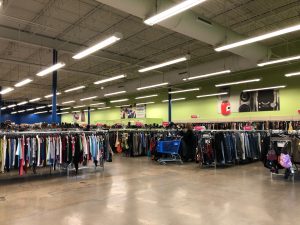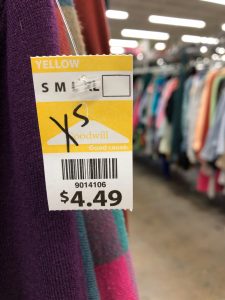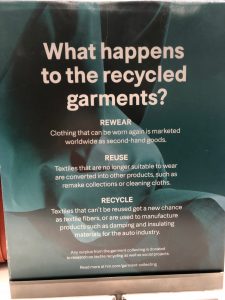The Sisterhood of the Traveling Pants, Shirts, & Shoes: The Afterlife of Secondhand Clothing
Jennifer Cunningham
Picture this: it’s Christmas morning and your family is all gathered around the tree, sipping on some hot coco and opening presents. You’ve already ransacked through the gifts that you’ve been waiting all year for and are hurrying to install the lightbulb into your new Easy Bake Oven. Before you’re allowed to start making your half-baked yet deliciously-home-made creations, your mom points to one more box left under the tree. From the boring rectangular shape, you can tell that this will not be a fun toy to play with. You tear open the packaging, open up the top, and find a scratchy red sweater with little reindeer stitched across the front. Putting on your best fake smile, you thank your mom for the lovely gift and toss the sweater into a pile that you plan to move up to your room later that night. You make a mental note to ask for the gift receipt to return the gift but get caught up in the holiday fun and entirely forget. A year later, while cleaning out your closet, you find the discarded sweater tucked into a corner with the tag still on it. You give it one look over, decide your mom probably doesn’t even remember buying it for you, and promptly throw it in a black bag that you will donate to Goodwill later that afternoon.
In an age where clothes have become so disposable, we thrive off of secondhand retailers that will gladly take these articles we have no desire for. In fact, we believe we’re actually doing a good, noble thing by giving our possessions away to those in need. However, how much do we …how much do we really know about the retailers we give our clothes away to? really know about the retailers we give our clothes away to? While many of these secondhand retailers pride themselves on their charitable nature, there seems to be a lack of information given by the management of these corporations to their customers and even their own employees. So, I set out to explore the secondhand clothing industry a bit more in two different sectors: non-profit, through Goodwill, and public retail, through H&M’s “Garment Collection Program.”
Goodwill Industries International Inc., or Goodwill for short, is one of America’s oldest non-profits. Founded in 1902, Goodwill started as a “hand up, not a hand out” ministry focused on

employing citizens and repairing used goods. Today, Goodwill has become a $4 billion enterprise that focuses on providing career training for underprivileged individuals as well as is a source for cheap, secondhand clothing (Goodwill Inc. 2019). For many, Goodwill is the perfect place to drop off old, unwanted clothes for a good cause. As soon as we drop off our bags of clothing at the doors, though, how do we really know where it’s going?
According to an article by lifestyle editor Suzy Strutner in the HuffPost entitled, “Here’s What Goodwill Actually Does With Your Donated Clothes,” Goodwill stores in New Jersey and New York got more than 85.7 million pounds of textile donations in 2018. Despite common perception, not every piece of clothing ends up out on the retail floor. According to Strutner’s research, the clothes donated to Goodwill have a path with 4 possible end stages. The first of these is the Goodwill retail store, of which there are 3,200 in the U.S.

From there, if an item doesn’t sell within 4 weeks, it moves along in the process to a Goodwill outlet. Here, clothes are sold at ultra-low prices, and these outlets are often termed “99 cent Goodwill stores.” Whatever isn’t sold at the outlets is moved on to Goodwill auctions, which take place both in-person as well as online at shopgoodwill.com. From there, the final place that donated clothes will go is to local textile recyclers. It has been found that 45% of clothing that makes it to these recyclers either is re-sold into the U.S. used clothing industry or is sent overseas. According to these textile recyclers, only 5% of the clothes they are given end up in landfills. They are confident in the fact that 95% of all clothing waste could be reused and recycled if disposed of properly.
At the Goodwill location on College Mall Road in Bloomington, IN, Skylar (employed since May 2019) confirmed some of these theories. He confirmed that Goodwill does get an abundance of

donations; well over 100 a day, with variation based on the changing of the seasons. Skylar estimated that 70% of donations get “processed,” or placed out on the floor of the store. The rest, he was told, gets salvaged for the outlet store location in Indianapolis. The majority of these textiles were pieces that had holes, stains, or were on a list of “do not produce.” These were typically articles that they had a surplus of; for example, right now they have a lot of summer clothing donations and have a surplus of sleeveless tops. Although he wasn’t entirely sure where the clothes go after that, he was fairly confident that the majority of textiles either went to customers or B2B companies.
It seemed that some of the facts found online lined up pretty closely to what Skylar was aware of, even as a relatively new Goodwill employee. Even though he wasn’t sure of all of the facts, it seemed that management at this location supplied their employees with a good amount of information on the afterlife of their donations. Following these discoveries, the next place to search for information was on the opposite end of the spectrum: the public retail side of secondhand donations. This investigation was slightly different, as I was focusing on a program rather than an entire store: H&M’s Garment Collection Program.
I actually found out about this program this summer, when I saw H&M advertising it on a sign outside their store. The sign informed me that, “The Garment Collection Program is a global initiative where H&M set out of a sustainable fashion future” (H&M 2019). Upon arrival into the store, an employee explained to me that for every bag you donate you will receive a 15% off coupon to be used at any time, and that the donations are reused, re-worn, or recycled. Since I was doing a big summer cleaning, I ended up bringing five bags into the store later that week, walking out with five 15% off coupons. While this seemed like a much better deal than just donating clothes to Goodwill for free, the incentives also seemed a bit too good to be true. I decided to delve into further research.

According to a 2016 article by Fast Company entitled, “How H&M is Trying to Balance Fast Fashion With Revolutionary Recycling,” this program has been pretty successful since its launch in 2013. In the retailer’s European recycling facility, it is said that around 25 to 30 trucks a day drop off an average of 13 metric tons of unwanted remainders from Europe’s closets. This program began after the company began to experiment with organic cotton in 2005 in an attempt to implement more sustainable practices. Their goal was to create a closed-loop system, where all raw materials for its clothes come from fibers that were already used (Edelbaum 2016).
However, not all news outlets seem to be singing the same praises of this initiative. A Newsweek article stated that H&M’s sustainability manager himself estimates that only 0.1% of all clothing collected by charities and take-back programs is recycled into new textile fiber. In fact, most of H&M’s salvaged clothing goes through the exact same process as they would at Goodwill (Wicker 2016). The fact is that commercially scalable, closed-loop textile …the H&M 2015 Sustainability Report states that nothing can be made “perfectly green”… because a garment can only be made of a maximum of 20% recycled fibers without falling apart. recycling technology is still five to ten years down the line, as even H&M’s “recycled” denim line only contained 20% reused cotton (Adams 2015). In fact, the H&M 2015 Sustainability Report states that nothing can be made “perfectly green” as their advertising suggests because a garment can only be made of a maximum of 20% recycled fibers without falling apart. Of course, this information is only seen in small, 10-point font next to an asterisk (H&M Conscious Actions). While H&M does seem to be trying to make things a bit more sustainable, its advertising turns out to be a bit exaggerated.
Just as with Goodwill, I wanted to conduct an in-person interview to learn more about what the employees in Bloomington know about the program. At the H&M in the College Mall, I approached one of the first employees I saw. She was very friendly and enthusiastic about my research, and promptly walked me over to the front counter to hand me a pamphlet while she answered my questions. However, another employee was within earshot of our conversation and promptly cut off her coworker, informing her that they are instructed not to discuss the

Garment Collection Program with customers. Despite her insistence I assured her that I wanted answers to some store-specific questions, and she hesitantly agreed. While she answered that the store gets about 10 donations a day, her answer to a lot of things was that “it varies.” She was especially not very forthcoming when I asked her if she knew exactly where the clothes were going. After a pause she hesitantly responded, “Yes, I know where the clothes are going… but as I’ve said you will need to refer to our website to receive the most accurate information.” After that she ran off in a hurry, clearly done with my questioning.
Although it’s most likely company policy to direct customer’s questions to the website, the way with which this employee engaged with me definitely left me with more questions than answers. The website did prove to be helpful in relaying H&M’s mission, which is to use only recycled or sustainably sourced materials by 2030 (H&M Group). However, while it stated facts on how many donations they receive on average, there were no statistics for how many of these materials actually end up getting recycled or re-used. The content focused mainly on what the company wants the program to be but not what it’s actually doing.
After conducting this primary and secondary research on Goodwill and H&M, I’m left with a lot of hesitation. Although both of these retailers do seem to have the best intentions at heart, there’s a lot of information that one has to go digging to find out. This extends to the employees of these companies as well; while the workers at Goodwill were much more forthcoming than those at H&M, there was still a level of uncertainty about the afterlife of their donated clothes. For those at H&M, although they were trying to be careful to protect their brand image, they came off as secretive and elusive. This leads me to believe that they may not actually know as much as they’d like us to think and are merely acting to promote the “wholly green” nature of their program’s advertising. In addition, both of these companies have incentive programs to get customers to shop more after donating: Goodwill offers a membership card that gives donors future discounts, and H&M provides their 15% off coupons. Is all of their work truly done with good intentions, or is it just a marketing scheme to get customers to buy more while appeasing some of their shopper’s guilt? While both of these retailers advertise good intentions, these incentive programs show they are not acknowledging the root of the cause; they are simply playing into the problem and encouraging it while acting like they’re making a change.
In this world we live in – where information is always going to be controlled from the top – the pursuit is always to search for meaning and truth. While advertising and marketing may be telling one story, it’s important to keep in mind that there is never just one story. The best thing we, as consumers and donors, can do is put forth the effort and ask the tough questions. While Goodwill and H&M may seem like the obvious and most convenient options, maybe it’s not always the most conscious way to go. There is irony in the fact that these retailers promote their giving nature while simultaneously offering incentives that reinforces the very consumer behavior that leads to an overflow of clothing in the first place. Perhaps the best thing to do the next time we’re digging through our closets and find that old, forgotten Christmas sweater is to take a step back and search for alternative secondhand retailers that are focused on the root of the problem: reducing consumption. The less we focus on being reimbursed and rewarded for our donations, the closer we will get to actually helping to make a difference in the way we dispose of our clothing.
References
Adams, Erika (2015). “H&M’s New Denim Line Is Made of Recycled H&M Clothes.” Racked. https://www.racked.com/2015/8/20/9182623/hm-recycled-denim#0
Edelbaum, Sussanah (2016). “How H&M is Trying to Balance Fast Fashion With Revolutionary Recycling.” Fast Company. https://www.fastcompany.com/90433617/qualcomm-is-talking-a-big-game-about-5g-in-2020-and-beyond
Goodwill Inc. (2019). “About Us.” Goodwill Inc. https://www.goodwill.org/about-us/
H&M (2019). “Garment Collecting: Be a Fashion Recycler.” H&M. https://www2.hm.com/en_us/women/campaigns/16r-garment-collecting.html
H&M Conscious Actions (2015). “H&M Conscious Actions Sustainability Report 2015” H&M. https://sustainability.hm.com/content/dam/hm/about/documents/masterlanguage/CSR/2015%20Sustainability%20report/HM_SustainabilityReport_2015_final_FullReport.pdf
H&M Group (2019). “Recycling and Upkeeping.” H&M Group. https://hmgroup.com/sustainability/Planet/recycling.html
Strutner, Suzy (2019). “Here’s What Goodwill Actually Does With Your Donated Clothes.” HuffPost. https://www.huffpost.com/entry/what-does-goodwill-do-with-your-clothes_n_57e06b96e4b0071a6e092352
Wicker, Alden (2016). “Fast Fashion is Creating an Environmental Crisis.” Newsweek. https://www.newsweek.com/2016/09/09/old-clothes-fashion-waste-crisis-494824.html
